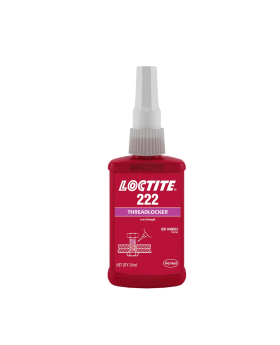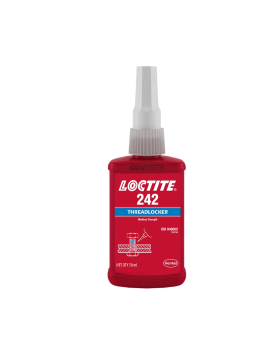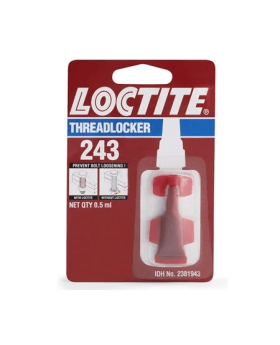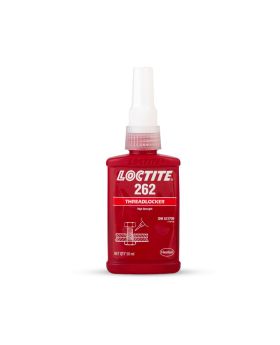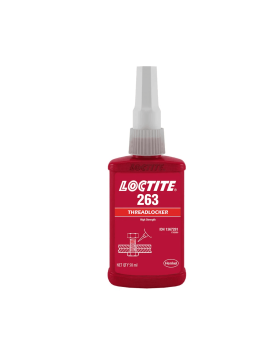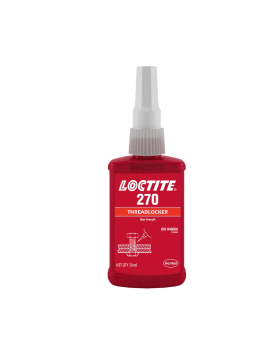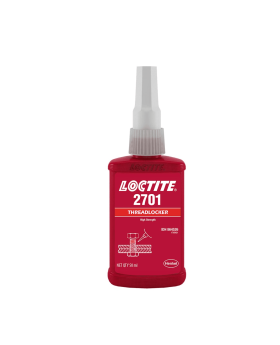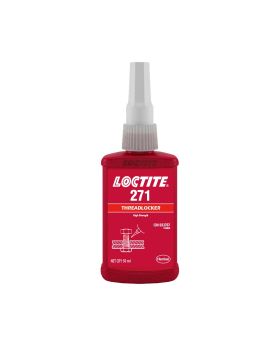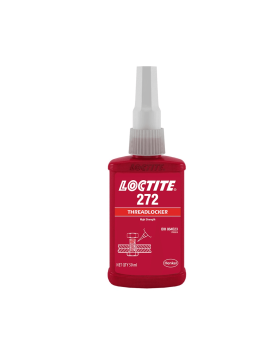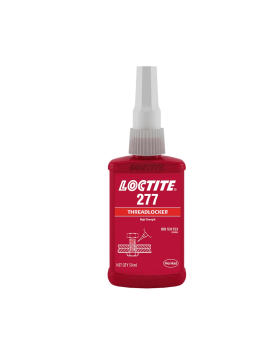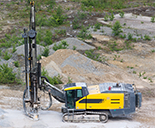Loctite Threadlockers


LOCTITE threadlockers are one of the most reliable and inexpensive ways to make sure a threaded assembly remains locked and secured for the entirety of its service life. Usually applied drop-wise to fastener threads, liquid LOCTITE threadlockers can fill all the gaps between the mating threads. Post application, they solidify to form a hard-thermoset plastic which locks the threads together and prevents unwanted loosening, leakage, and corrosion.
Adding an additional nut does not eliminate the gaps which LOCTITE can fill completely.
WHY CHOOSE LOCTITE THREADLOCKERS?

Lock threaded
assemblies against
vibrational loosening:
- Fills 100% of the gap
between threads of nut
and bolt which eliminates
the root cause of
vibrational loosening

Outperform All
Locking Devices:
- Better clamp load
retention compared to all
mechanical locking devices

Increase End Product
Service Life:
- Higher off-torque
provides
additional safety

Prevent Galling
and Corrosion:
- Protects against corrosion
by forming an impenetrable
layer between nut
and bolt threads - Liquid film prevents friction
welding or galling between
nut and bolt threads

Permit Disassembly:
- Low and medium grades
allow disassembly with
standard hand tools

Minimize Inventory Cost and Complexity:
- One size fits all - applicable
for a wide range of
fastener sizes

Save Cost:
- Lower cost per unit
compared to most
locking devices

Increase Durability:
- Thermal Resistance of
up to 150 C and higher - Able to withstand most
industrial gases and fluids - Field proven for decades
HOW TO SELECT THE RIGHT LOCTITE THREADLOCKER?
To choose the best threadlocker, simply answer these three questions:
- What is the fastener size?
- What is the required strength?
- How frequently do you service the equipment?











Industrial Manufacturing Maintenance
Industrial equipment manufacturers design and build machines that make other machines and end products.
LOCTITE products help industrial equipment manufacturers in maintaining smooth operations and high productivity of all machines.
-
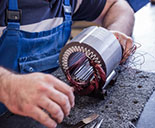
Maintenance of Electric Motors
-

Maintenance of Pumps
-

Maintenance of Gearbox
The harsh environment of the paper and pulp industry leads to a variety of maintenance challenges.
LOCTITE can help in eliminating the challenges and increase the productivity of machines.
-

Maintenance of Electric Motors
-

Maintenance of Pumps
-

Maintenance of Gearbox
The versatile end products manufactured put immense stress on the processing machinery.
LOCTITE products help the machines run smoothly under extreme working conditions, while maintaining high productivity.
-

Maintenance of Electric Motors
-

Maintenance of Pumps
-

Maintenance of Gearbox

The LOCTITE®X digital manual for creating reliable and effective bonded joints. A must-have resource for professionals in the adhesive industry who want to master their knowledge and unleash their potential.
START READING
LOCTITE offers a wide range of threadlockers suitable for various applications. For best results, it is critical to apply the right threadlocker to increase the reliability of threaded assemblies.
Know More
LOCTITE threadlockers come in various strengths, coded by characteristic colours, to cater to a wide variety of applications across industries.
Explore The Range
LOCTITE®️’s Threadlockers increase reliability & prevent threaded assembly failure with some impressive bond strengths and clamp load retention during vibrational cycles. However, you can easily disassemble fasteners assembly when the need arises using proper tools and correct techniques.
Read More
LOCTITE threadlockers offer a host of benefits by filling in all gaps between close fitting threaded parts, making man and machines unstoppable.
Know More
Here is a complete know-how of the functioning of a threaded fastener. Get acquainted with the science behind the humble nut and bolt.
Know More
Here is a sneak-peek into the functioning of a threaded fastener. Get a complete understanding of the loosening scenario.
Know More
Understanding the various factors that affect the overall performance of a threaded fastener can help prevent catastrophic failures.
Know More
LOCTITE threadlockers are a reliable alternative to locking threaded assemblies against vibration and produces assemblies that can be disassembled when required.
See The Proof
LOCTITE 243 is a one stop solution to lock loosening nuts and bolts by making threaded assemblies 25% stronger. Its versatility allows it to fit all sizes of threaded fasteners and makes it a must have for your maintenance kit.
Read More
At times it can be difficult to choose the right threadlocker for your application, especially if two products have very similar properties. We have made the selection of a general purpose variant easier for you.
Learn More
Read how a paper mill eliminated the loosening of set screws with the use LOCTITE 222 Threadlocker and prevented further damage to shafts and bearings.
Read MoreHere’s a list of queries with responses that might help you.
We need to reopen the fastener. Can Loctite threadlockers be removed?
Yes, LOCTITE threadlockers can be removed as and when needed. The low strength grade of LOCTITE threadlockers can be removed by applying a loosening torque higher than the tightening torque. The high and medium strength threadlockers by LOCTITE can be removed easily by applying localised heat (250 degrees Celsius) to the part, for disassembly.
How can we visibly determine whether LOCTITE threadlocker has actually been applied to the nut and bolt or not?
All LOCTITE threadlockers have the property of fluorescence. When you disassemble, you can easily find out whether LOCTITE threadlocker has been applied or not by the presence of a white powder on the bolt. In the uncured form, LOCTITE threadlocker can be identified by its colour (Purple-Low strength; Blue-Middle Strength; Red-High Strength)
Our bolting locations are such that it is difficult to reach for application of threadlocker. Is there a LOCTITE threadlocker that can help?
Yes. With LOCTITE 290, a wicking grade LOCTITE threadlocker, you can lock the nuts and bolts which are difficult to apply otherwise. You can simply apply a few drops near the joint where the bolt head meets the part, and LOCTITE 290 will wick inside the nut-bolt interface due to capillary action.
Can LOCTITE threadlockers migrate to and jam other parts?
No. LOCTITE threadlockers are thixotropic in nature and hence don't tend to flow to other parts. Also, LOCTITE threadlockers only need to be applied on the nut-bolt interface and once the nut covers the area where LOCTITE threadlocker was applied, the adhesive will get cured in the absence of air and presence of metal, thereby turning into a thermoplastic, which cannot flow.
LOCTITE threadlockers being liquid, will create a mess during application to which our operators will object. How can we deal with that?
LOCTITE threadlockers come with a nozzle for precise drop-by-drop application. Hence, there is no scope for a mess. In case of any spillage, you can wipe it off easily because as long as LOCTITE threadlocker is in contact with air, it will remain a liquid and not cure at all.
The fasteners used to hold our machinery are big and a constant load and vibration is exerted. Is there a LOCTITE threadlocker that can help?
Yes. There are some high strength threadlockers that can lock fasteners which are big and able to resist extreme vibrations. Please refer to the product selector tool to find a suitable threadlocker.
If LOCTITE threadlockers cure in the absence of air, why don’t they cure inside the bottle?
The reason is anaerobic bottles are specially formulated with air-permeable polyethylene bottles which allow air to pass through the wall. There is also some air gap over the product inside the bottle to maintain the stability of the product. Thus, a 50 ml pack of LOCTITE threadlocker contains 50 ml adhesive but in a much larger bottle.
What is fixture time?
The fixture time is the time taken by an adhesive like threadlocker to provide initial handling strength to the locked/sealed components. Once the fixture time gets over, you can take the assembled component for further processing on the assembly line.
What is cure time?
The cure time is the time taken by the adhesive (threadlocker) to completely become a tough structural solid (thermoset plastic).
Can I use a threadlocker for non-threaded assemblies like locking bearings on bushings in housings or on shafts?
Yes, you can. Normally we recommend retaining compounds like LOCTITE 638 for such applications, but both threadlockers and retaining compounds are the same in terms of chemistry i.e. they are both anaerobic. Inversely, you can use retaining compounds to lock threaded assemblies but then the locking will be permanent.
Can I use anaerobic where one or both parts are made of plastic?
Anaerobic like threadlockers are normally not recommended for use with plastics as they can result in stress cracking or softening. In such cases, cyanoacrylates are recommended.
Do I need to use a primer with LOCTITE threadlocker?
We recommend the use of primer if both the parts come under the category of 'inactive surfaces'. Because such metals lack iron or copper content, the metallic ions are required to fully cure the product within 24 hours. Moreover, these inactive surfaces include plated parts, stainless steel, galvanized steel and anodized aluminium to name a few. However, in case both or at least one part is an active metal, then there is no need to use a primer to ensure full cure – typically within 24 hours at room temperature.
Can LOCTITE threadlockers be used on oil-impregnated parts?
Yes, LOCTITE 243 threadlocker can be used on oil-impregnated parts as it can cut oil effectively and lock properly. Just clean the part once before you apply the product.
What is breakaway torque?
When we apply a threadlocker to a bolt, we hand tighten the nut down and let it sit for 24 hours to get fully cured. Now, we take a torque wrench and break the bond. The torque needed to break the bond is called the breakaway torque. Note that we have not applied any additional tightening torque to the parts. Thus, the breakaway torque gives us the strength of the threadlocker alone.
What is prevailing torque?
When we apply a threadlocker to a bolt, we finger tighten a nut down and let it sit for 24 hours to cure fully. Then, we take a torque wrench and break the bond. After breaking the bond, we continue to turn the nut around by four quarters(360°), which provides us with the prevailing torque value. This shows us how much friction or drag is left to continue turning the nut.
What is breakloose torque?
When we apply threadlocker to a bolt, we tighten it by giving a tightening torque. The torque at which the nut can be taken off entirely is the breakloose torque. The main function of the threadlocker is to maintain the torque. It has been determined that over time, due to various factors like vibration, side sliding etc., there is a loss of up to 30% of the torque to the parts. The goal is to select a threadlocker that will offer a breakaway value equivalent to 30% of the initial torque in order to maintain your torque over time. For ex: Let's say that a tightening torque of 10 Nm was given to the assembly. The breakaway torque (strength provided by the threadlocker) is 5 Nm. Now due to vibrations, there is a 3 Nm loss in tightening torque. So if you do not apply a threadlocker, your assembly tightened at 10 Nm will open at 7 Nm. Whereas, by applying a threadlocker, your assembly tightened at 10 Nm will have the total torque of (10+5) 15 Nm and even on 30% loss, it will open at 12 Nm, which is higher than your tightening torque. This is what is known as torque augmentation with LOCTITE threadlockers.
What is the proper way of applying LOCTITE threadlockers for blind hole applications?
In order to ensure complete coverage and cure, apply LOCTITE threadlocker to both the male and female threads for blind hole applications such as a bolt going into a closed housing. If it is applied only to the male threads and torqued down, air pressure will force most of the product back out as you assemble.
Can the curing process of anaerobic be accelerated via heat?
Yes, heat can help achieve faster cure. Typically one can heat cure LOCTITE threadlockers at 125 degrees celsius for 1 hour, or go as low as 66 degrees celsius for 3 hours. The trade-off here is that there will be a reduction in strength to a certain extent. Please refer to the Technical Data Sheet of the selected product for testing the suitability.
How do I determine how much threadlocker I need to apply?
We have developed a calculator to help you with the amount of LOCTITE threadlocker you need for your application.
How do I select the right threadlocker to suit my requirement?
To help you select the right product for your requirement, we have developed a product selector tool. Just enter your requirements and the tool will provide you with the best
 Product Recommender
Product Recommender  Value Calculator
Value Calculator  Track Order
Track Order
 1800 123 1922
1800 123 1922 





















































 Maintenance
of Pumps
Maintenance
of Pumps
 Maintenance
of Electric
Motor
Maintenance
of Electric
Motor
 Maintenance
of Gearbox
Maintenance
of Gearbox
 Maintenance
of Compressor
Maintenance
of Compressor
